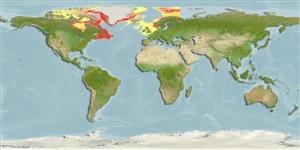Issue
Taxonomic status of the populations inhabiting the Okhotsk Sea, Bering Sea, coast of Greenland, and Eurasian seas need to be clarified (Ref. 51659).
Environment: milieu / climate zone / depth range / distribution range
Ecology
Marine; demersal; depth range 0 - 930 m (Ref. 50550), usually 75 - 230 m (Ref. 42091). Polar; 83°N - 43°N, 117°W - 36°E (Ref. 57308)
Arctic to Northwest Atlantic and Northwest Pacific: Grand Bank and Gulf of St. Lawrence, Canada in western Atlantic (Ref. 7251). Eastern Atlantic: Spitsbergen and Finmarken coasts in Norway eastward to White Sea, Barents Sea and Kara Sea; also Iceland and Greenland. Also Okhotsk and Bering seas.
Size / Weight / Age
Maturity: Lm ? range ? - ? cm
Max length : 21.0 cm TL male/unsexed; (Ref. 4700)
Inhabits muddy bottoms at temperatures of 4.4 to -1.7 °C (Ref. 4700). Benthic, possibly bathypelagic (Ref. 58426). Feeds on pelagic and benthic crustaceans and polychaetes (Ref. 4700).
Life cycle and mating behavior
Maturities | Reproduction | Spawnings | Egg(s) | Fecundities | Larvae
Andriashev, A.P., 1986. Agonidae. p. 1265-1268. In P.J.P. Whitehead, M.-L. Bauchot, J.-C. Hureau, J. Nielsen and E. Tortonese (eds.) Fishes of the North-eastern Atlantic and the Mediterranean. volume 3. UNESCO, Paris. (Ref. 4700)
IUCN Red List Status (Ref. 130435)
Threat to humans
Harmless
Human uses
Tools
Special reports
Download XML
Internet sources
Estimates based on models
Preferred temperature (Ref.
123201): -0.9 - 6.7, mean 0.7 °C (based on 505 cells).
Phylogenetic diversity index (Ref.
82804): PD
50 = 1.0000 [Uniqueness, from 0.5 = low to 2.0 = high].
Bayesian length-weight: a=0.00389 (0.00180 - 0.00842), b=3.12 (2.94 - 3.30), in cm total length, based on all LWR estimates for this body shape (Ref.
93245).
Trophic level (Ref.
69278): 3.2 ±0.35 se; based on food items.
Resilience (Ref.
120179): Medium, minimum population doubling time 1.4 - 4.4 years (Fec = 1,088).
Fishing Vulnerability (Ref.
59153): Low vulnerability (11 of 100).
Nutrients (Ref.
124155): Calcium = 26.6 [6.0, 93.6] mg/100g; Iron = 0.502 [0.170, 1.213] mg/100g; Protein = 1.92 [0.00, 5.69] %; Omega3 = 0.323 [0.122, 0.886] g/100g; Selenium = 11.6 [3.7, 40.8] μg/100g; VitaminA = 16.3 [3.3, 76.3] μg/100g; Zinc = 0.534 [0.276, 1.070] mg/100g (wet weight);
